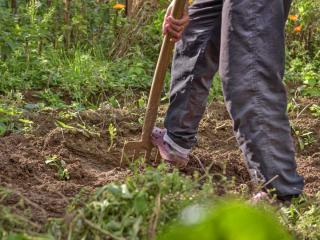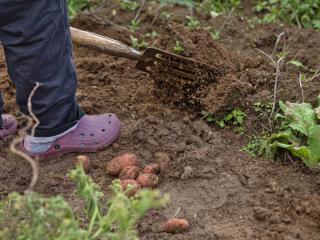

The spading fork, also called digging fork, is an essential tool for every gardener. You can use it to make many jobs much easier. It’s a good alternative to the standard spade, often more destructive than a spading fork is. Here’s everything you need to know about the spading fork: definition, advantages, and uses in the garden.
→ Also read:

Different designs are available, from those with stainless steel “prongs”, a crutch handle or a ball handle which can be made of wood or composite materials.
A digging fork is especially useful for working heavy soil. It can easily penetrate the soil and loosen it without turning it over. In fact, it serves the same function as a standard spade but avoids trauma on fauna present in the soil. Earthworms and subsoil microbial life are is spared the sharp, slicing blade.

As mentioned earlier, the digging fork is first used to till the soil. You would mainly use it in the vegetable patch to till heavy and clay soils. It requires less effort than a standard spade.
The digging fork also has other functions, particularly that of pulling out clumps of wild grass. A simple lever movement here allows you to extract whole weeds from the soil. Just grab the loose clump and shake extra dirt out to recover soil trapped by roots of the unwanted plant.
Another use of digging forks is to divide clumps of bulb plants (dahlia, daylily, iris). The tool allows easy extraction of a bulb from the soil, without risking cutting it, as would be the case with a standard spade.
It is also better to use a digging fork to gently work the soil around trees and shrubs. It helps to limit damage on the shrub’s roots, where a standard spade tends to cut them clean.
Used in the vegetable garden or in your ornamental beds like a bio-fork, the digging fork allows soil aeration without turning it over, thanks to a simple lever movement. The tool can even help specifically for this in light and sandy soil.
The digging fork is commonly used to lift and move piles of hay or straw, especially to feed animals. It is also very useful for cleaning the bedding of these same animals, and for moving manure. It’s a bit heavy compared to normal pitchforks, so if you often have large amounts to move, you might prefer having one of those instead.

For a more ergonomic tool, prefer a digging fork equipped with a T-handle (kickstand) or a horse-shoe handle, which provides better support than a simple straight rod. Also, ensure that the length of the handle is suited to your height, with available lengths being between 3.3 feet (1 m) and 4.3 feet (1.3 m).
→ Also read: